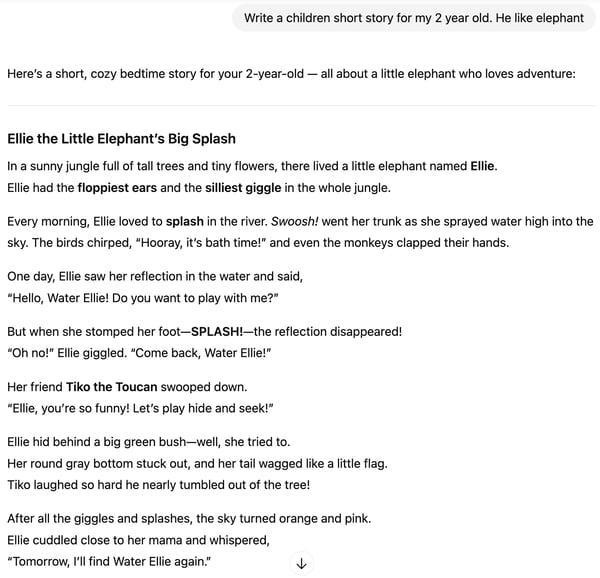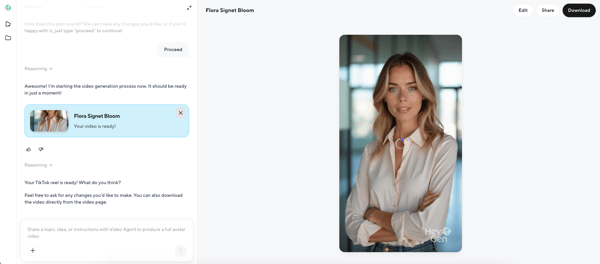October 13, 2025
 by Soundarya Jayaraman / October 13, 2025
by Soundarya Jayaraman / October 13, 2025

That celebrity endorsement? Fake. The news clip you just watched? AI-generated. The podcast host’s voice? Entirely synthetic.
On TikTok and Instagram, “babies” are posting emotional confession videos, only they’re not real infants but AI-generated faces trained to mimic human expressions. A deepfaked Tom Cruise casually cracks jokes and plays golf on social media. Virtual influencers like Lil Miquela, who are landing brand deals that most real creators could only dream of, are actually AI-generated. Even news outlets are experimenting with AI-generated anchors to deliver the day’s headlines.
Welcome to the uncanny frontier of synthetic media, where algorithms are the new artists and authenticity is a topic of debate. But what is synthetic media?
Synthetic media refers to content created using artificial intelligence, including images, video, audio, and text. Tools like deepfakes and AI-generated voices are common examples. Synthetic media is used in entertainment, marketing, and misinformation, raising ethical and regulatory concerns.
Take a look at this video, for example. It's a clip created entirely using an AI video generator.
Synthetic media software like AI writers, AI image generator, AI video generators, AI music makers, and text-to-speech tools, can now produce entire pieces of content that once required human imagination and technical skill. In minutes, these tools can compose music, write articles, generate hyperrealistic imagery, or clone a human voice with uncanny accuracy.
It isn’t just reshaping entertainment; it’s rewriting how we perceive truth, trust, and creativity online.
In this article, we’ll explore how synthetic media works, where it’s being used, and why it’s rapidly becoming one of the most disruptive forces in digital content creation.
From AI-generated art to cloned voices and virtual influencers, you’ll see how this technology is transforming industries and challenging our very sense of reality. We'll also explore critical questions about ownership, consent, misinformation, and the future of creative integrity in a world where anything can be fabricated.
At its core, synthetic media is powered by generative AI models trained on vast datasets of text, images, audio, and video. These models learn patterns, how people speak, move, and write, and then use that knowledge to create new, realistic-looking (or sounding) content.
Different types of AI architectures drive different forms of synthetic media:
Beyond these core architectures, technologies like transformers and diffusion models enable advanced text-to-speech and text-to-image generation. These systems can transform simple prompts into natural-sounding audio or hyperrealistic visuals, illustrating how quickly AI can turn language into media.
Together, these systems form the backbone of synthetic media—turning data into digital creativity at a speed and scale never seen before.
The result? Media that feels human-made but is entirely algorithmic, created not by cameras or microphones, but by code.
Synthetic media is constructed partially or entirely by computers. Non-synthetic media refers to any media created conventionally, i.e., media produced with human input.
Think about it this way:
Both serve the same purpose of sharing information, but their origins are entirely different: one is driven by data and algorithms, while the other is driven by human intent and experience.
Synthetic media comes in various forms, depending on the type of content being generated. While the technology behind each may differ, the goal is the same: to create human-like media more quickly, affordably, and at scale.
From blog posts and news articles to marketing copies and stories and novels, AI writing tools can now create natural-sounding text based on prompts or datasets. Platforms like ChatGPT, Jasper, and Copy.ai use large language models to generate everything from marketing content to technical documentation. Take a look at ChatGPT generating a children's story below. 
Explore the best AI writing tools reviewed by my colleague to find out which platforms deliver the best mix of creativity, accuracy, and efficiency.
Text-to-image models, such as DALL·E, Midjourney, and Stable Diffusion, can transform short text prompts into detailed visuals — ranging from art and product mockups to photorealistic portraits. These systems are trained on vast image datasets and can blend concepts, styles, and emotions in entirely new ways. Here's an example of an AI-generated image of a city's skyline.

Video generators, such as Synthesia, Pika, and Runway, allow users to create realistic video content without the need for cameras or actors. They can animate avatars, sync lip movements to scripts, or generate entire scenes with minimal input.

AI tools can compose background music, mimic instruments, or clone human voices. Examples include tools like Soundful and Suno for music, or ElevenLabs for realistic voice generation. This has major implications for podcasts, ads, and entertainment production.
From lifelike brand ambassadors to digital personalities like Lil Miquela, AI avatars are reshaping influencer marketing and digital entertainment. These personas can be entirely fictional yet interact with their audiences in real-time.
![]()
These types of synthetic media highlight how deeply AI is blending into creative and communication workflows
Synthetic media is no longer confined to research labs or niche creative projects. It’s quietly becoming part of everyday workflows across industries.
With the rise of generative AI chatbots and creative tools, its use cases have expanded dramatically. People now use AI to write social media posts, blog articles, and emails; to design visuals for personal and professional brands; and to produce short-form videos for platforms like TikTok, Instagram, and YouTube. Synthetic media isn’t a niche technology anymore; it’s part of daily digital life.
On the business side, from marketing campaigns to entertainment and education, it’s transforming how content is made, personalized, and scaled. What makes it remarkable isn’t just the technology; it’s how seamlessly it’s blending into human creativity. The best results today don’t come from AI replacing creators, but from humans who know how to collaborate with it.
Brands use AI-generated videos, voices, and visuals to create campaigns in multiple languages and styles without expensive studio setups. Virtual influencers and AI avatars are becoming brand ambassadors, offering a way to reach audiences 24/7 while staying perfectly on message.
For example, Coca-Cola’s “Create Real Magic” campaign let users generate custom artwork with OpenAI models, blending brand storytelling with consumer creativity.
Filmmakers and game developers are using AI to generate realistic characters, backgrounds, and even dialogue. Synthetic actors can perform without reshoots, and AI music generators are scoring entire soundtracks, cutting production time dramatically. In fact, people are even creating their own games using generative AI tools
Studios use generative models for rapid prototyping, character design, and trailer generation to test audience reactions before release.
Synthetic media helps educators and organizations create immersive learning experiences. AI avatars and text-to-speech tools can turn written material into interactive video lessons, making content more engaging and accessible across languages.
Platforms like Synthesia enable instructors to generate multilingual training videos featuring virtual presenters without recording a single clip.
Companies are using synthetic media to scale internal communication, sales enablement, and onboarding. AI-generated training videos, personalized executive updates, and multilingual presentations can be produced in minutes, reducing costs while improving consistency and reach across global teams.
Beyond training, organizations are also turning to synthetic media for customer education, like creating quick product tutorials, onboarding walkthroughs, and help center videos without requiring a production team. HR departments use AI avatars for policy explainers and culture onboarding, making large-scale communication more engaging and human-like.
Some companies are experimenting with personalized internal messaging, where an AI-generated version of a company leader delivers tailored updates to different departments or regions.
Media outlets are experimenting with AI-generated anchors and automated news summaries to deliver faster, localized updates. This use case also highlights the growing need for transparency in AI-generated content.
For example, Xinhua News Agency introduced AI-powered news anchors capable of reading stories around the clock, demonstrating both efficiency and ethical complexity.
Text-to-speech and AI dubbing tools make content accessible to people with disabilities or language barriers. An AI voice can narrate written material for the visually impaired or instantly translate and voice over videos in multiple languages.
For example, YouTube’s automatic dubbing features and modern voice cloning tools help creators reach global audiences with natural-sounding multilingual narration.
Synthetic media tools are redefining our work with more intelligent, more efficient methods that produce media experiences of unprecedented quality. The primary benefits include:
Now, Synthetic media also introduces complex ethical, creative, and societal challenges that require careful navigation.
Now, the challenges of synthetic media don’t mean we should avoid using it altogether. In fact, these tools are transforming how we work, communicate, and create, both personally and professionally. However, as the boundaries between the real and the synthetic blur, it’s essential to use them responsibly and transparently. Here are some key best practices to follow when creating synthetic media:
The market for synthetic media software is constantly developing as new competitors and cutting-edge technologies challenge established standards. These platforms give us complete control over our synthetic media, with stringent and comprehensive privacy standards to guarantee the tool is utilized safely.
Here are the top-rated tools to explore based on the G2 Fall 2025 Grid® for Synthetic Media Software:
The future of synthetic media lies in real-time, hyper-personalized content creation. As generative AI models improve, we’ll see brands producing on-demand ads tailored to individual viewers, educators creating interactive learning avatars, and journalists using AI to generate localized stories. Regulation, ethical frameworks, and watermarking technologies will likely evolve alongside to ensure transparency and authenticity.
The biggest risks include misinformation, copyright violations, and the misuse of someone’s likeness without consent. Deepfakes and voice clones can be weaponized for fraud or manipulation, while bias in AI datasets can lead to unfair or misleading outputs. That’s why responsible use, disclosure, and fact-checking are essential in any synthetic media workflow.
You don’t need to be a programmer to create synthetic media today, but key skills help: basic understanding of AI tools, creative storytelling, video and audio editing, prompt writing, and data ethics. For advanced creators, familiarity with deep learning concepts, data curation, and model fine-tuning can unlock greater control and originality.
AI-generated text often shows subtle signs like overly polished tone, repetitive phrasing, or a lack of nuanced detail. AI content detectors like GPTZero and OpenAI’s classifier can help flag AI-written text. Always cross-check sources, verify quotes, and look for inconsistencies in context or tone.
Look closely for visual irregularities such as distorted hands, asymmetrical faces, inconsistent lighting, or unrealistic reflections. Reverse image search can reveal if a picture originated from an AI model. Tools like Hive AI, Reality Defender, and watermark detection systems can also identify synthetic visuals.
AI-generated videos may feature unnatural eye movements, inconsistent lip-syncing, or slight timing delays in gestures. Frame-by-frame analysis can reveal visual glitches or mismatched lighting. Platforms like Deepware Scanner and Sensity AI specialize in detecting deepfakes and synthetic video content.
We are at the beginning of a paradigm change. Content creation is shifting from the physical to the digital realm, enabling us to produce work that we never could before. Synthetic media is gradually growing in terms of realism and simplicity of use while also producing excellent results.
However, it’s also vital to note that AI and related technologies cannot be produced with ethics as a secondary consideration. Principles must be front and center, an inherent part of every organization, reflected in business policy, and in these revolutionary technologies.
If you’re intrigued by synthetic media, explore a little about the best generative AI tools that you can start using today to create visuals, videos, and content effortlessly.
This article was published in 2023 and has been updated with new information.
Soundarya Jayaraman is a Content Marketing Specialist at G2, focusing on cybersecurity. Formerly a reporter, Soundarya now covers the evolving cybersecurity landscape, how it affects businesses and individuals, and how technology can help. You can find her extensive writings on cloud security and zero-day attacks. When not writing, you can find her painting or reading.
Producing high-quality videos used to mean expensive gear, endless editing, and long...
 by Soundarya Jayaraman
by Soundarya Jayaraman
I’ll be honest and admit right away that when AI tools like DALL-E and GPTs started popping...
 by Soundarya Jayaraman
by Soundarya Jayaraman
As a marketer and an AI enthusiast, I'm always looking for tools that make creativity faster,...
.png) by Shreya Mattoo
by Shreya Mattoo
Producing high-quality videos used to mean expensive gear, endless editing, and long...
 by Soundarya Jayaraman
by Soundarya Jayaraman
I’ll be honest and admit right away that when AI tools like DALL-E and GPTs started popping...
 by Soundarya Jayaraman
by Soundarya Jayaraman


